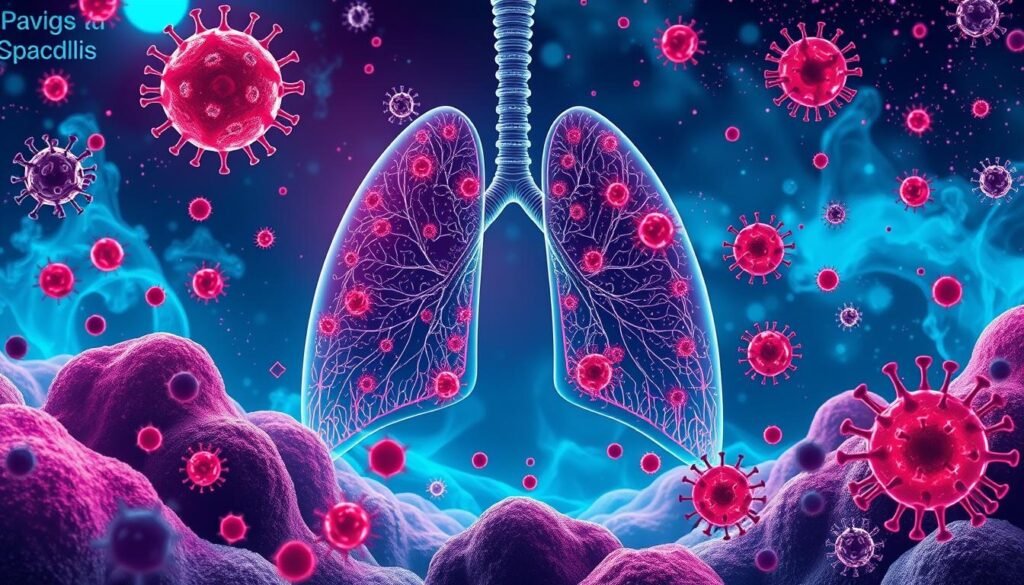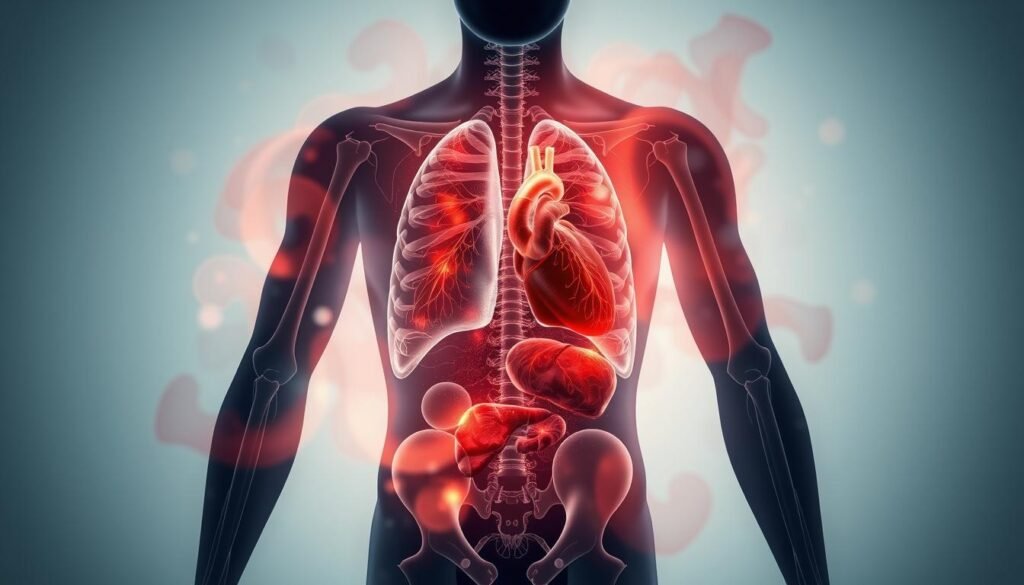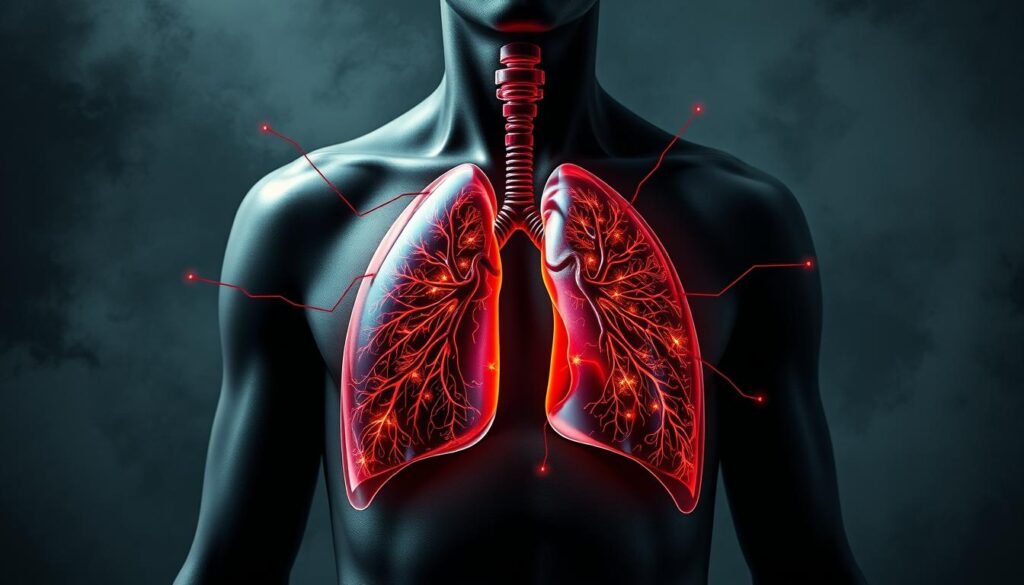Lung cancer is the number one killer among all cancers worldwide, with about 1.8 million people dying from it every year. This fact stresses how vital it is to know what organs does lung cancer affect. Though it starts in the lungs, lung cancer can spread to different organs. This spread results in a range of lung cancer symptoms depending on which organs are affected.
The cancer can move to the heart, blood vessels, liver, and even the brain. Understanding how lung cancer spreads helps us know the disease’s effect on the body. Spotting the signs early can make a big difference in treatment and how well patients do. It’s key for people to get checked right away if they notice symptoms linked to lung cancer treatment. Finding the disease early and getting the right treatment plan is crucial.
Key Takeaways
- Lung cancer is the leading cause of cancer deaths worldwide, affecting numerous organs.
- Metastasis can lead to complications in vital organs like the brain, bones, and liver.
- Recognizing lung cancer symptoms early can enhance the chances of effective treatment.
- Both smokers and non-smokers can develop lung cancer, though risks vary considerably.
- Comprehensive knowledge of treatment options is critical for managing the disease.
- Understanding the pathways of lung cancer metastasis is crucial for effective patient care.
Understanding Lung Cancer
Lung cancer is a major health issue in the United States. It closely links to various health organs. The two main types are non-small cell lung cancer (NSCLC) and small cell lung cancer (SCLC). Around 80% to 85% of lung cancers are NSCLC. This group has subtypes like Adenocarcinoma, Squamous Cell Carcinoma, and Large Cell Carcinoma. Adenocarcinoma is notably the most common NSCLC type. Squamous cell carcinoma often links to smoking.
Smoking is the number one risk factor for lung cancer. But, non-smokers can also fall sick if they encounter harmful substances. This includes radon gas and various carcinogens. Genetic changes also play a role, highlighting environmental and genetic risks.
Finding lung cancer early is hard because symptoms usually show up late. This makes diagnosing lung cancer tough. Signs to watch for include lasting coughs, wheezing, chest pain, and blood in mucus. Doctors often use chest X-rays or CT scans to spot tumors.
It’s vital to grasp the different lung cancer types and their causes. Knowing these helps in crafting effective treatment plans. Options include surgery, chemo, and radiation. There are also newer methods like immunotherapy and targeted treatments. Understanding these options helps doctors offer the best care for this serious disease.
Initial Impact of Lung Cancer on the Respiratory System
Lung cancer mainly impacts the respiratory system early on. Patients might notice symptoms like a persistent cough, chest pain, and breathing troubles. These symptoms happen as lung tumors get bigger. They can block or inflame airways, making normal breathing hard.
Feeling out of breath, or dyspnea, is a common worry. Lung cancer may block airways, lead to fluid buildup, or lower red blood cell counts. These issues can cause this feeling. Yet, treatments like bronchoscopy can help ease these symptoms and make life better.
Know the early signs well. Symptoms like ongoing bronchitis, a hoarse voice, or coughing blood can mean the cancer is advancing. This makes the lung cancer prognosis harder. Early detection is key, especially for those at high risk.
https://www.youtube.com/watch?v=ihCnDjyJv5c
Leading a healthy life can fight some of these effects. Steps like stopping smoking and staying away from secondhand smoke help. So does drinking plenty of water, getting enough rest, and eating well. Deep breathing exercises can also benefit those with lung cancer symptoms.
What Organs Does Lung Cancer Affect
Lung cancer mainly affects the lungs and the airways. It starts in any part of these areas. As it grows, tumors can spread to the airway system and the lung’s protective layer. This shows how lung cancer can move to other organs.
The Lungs and Airway System
The right lung has three lobes while the left has two. This shape allows tumors to grow, causing breathing problems. Most lung cancers are called non-small cell lung cancer. The rest are small cell lung cancer, which spreads quickly, so early detection is essential.
Migratory Pathways for Cancer Cells
Lung cancer can move to other organs via the lymphatic system and bloodstream. It often spreads to the lymph nodes, liver, brain, and bones. This spread shows lung cancer’s big impact, underlining the need for early detection and treatment.
Effects on the Circulatory System
Lung cancer greatly affects the circulatory system. When cancer enters the blood, it can reach different organs and cause big health problems. This spread isn’t limited to the lungs. It includes other vital areas too. That’s why it’s key to notice the early signs of lung cancer.
How Lung Cancer Spreads through Bloodstream
Cancer cells can move to other organs via the bloodstream. This affects the heart, liver, and kidneys. Such spreading makes lung cancer more serious. It raises the risk of blood clots. Spotting symptoms early can really change the chances of beating the disease.
Risks of Blood Clots and Pulmonary Embolism
Lung cancer patients are more likely to get blood clots. These clots can cause pulmonary embolism if they reach the lungs. This is very dangerous. Signs include breathlessness, chest pain, and coughing up blood. Such symptoms need quick medical help.
It’s very important to understand how lung cancer affects the circulatory system. Early symptom recognition and medical advice can hugely affect the treatment outcome.
| Condition | Potential Symptoms | Impact on Prognosis |
|---|---|---|
| Pulmonary Embolism | Sudden shortness of breath, chest pain, blood in coughs | Can worsen lung cancer prognosis, requiring urgent care |
| Liver Metastasis | Jaundice (yellowing of skin and eyes) | May indicate advanced disease stage |
| Cancers Spreading to Heart | Fatigue, arrhythmias | Presents additional challenges in treatment |
Impact on the Cardiovascular System
Lung cancer can really affect the heart and the areas around it. Even though it’s rare, when it happens, it can cause big problems. People might feel chest pain or their heart may beat oddly. This shows why it’s crucial to watch the heart health of those with lung cancer closely.
Cancer and its treatments, like chemo or radiation, can hurt the heart long after. They can make existing heart problems worse or cause new ones. This means doctors need to carefully plan out lung cancer treatment. Sometimes, heart issues from treatment need quick action and special care.
Every year, about 17.9 million lives are lost to heart disease worldwide. It’s the number one killer. Lung cancer and heart problems often share causes, such as smoking and long-term inflammation. Heart attacks and heart failure are big worries for lung cancer patients.
To handle heart risks in lung cancer patients, regular doctor visits and healthy lifestyle changes are key. Sometimes, treatments to improve blood flow might be needed. Keeping an eye on heart health during lung cancer treatment helps with better outcomes for patients.
Effects on the Immune System
The immune system is heavily challenged as lung cancer spreads to nearby lymph nodes. This spread makes the disease more complex. It affects how long people with lung cancer might live. Cancer cells moving into lymphatic tissues trigger the body to respond, causing symptoms like swollen lymph nodes and signs of being sick all over.
Metastasis via Lymph Nodes
When lung cancer reaches the lymph nodes, it’s usually a sign of a tougher fight ahead. This situation often means a worse outcome for patients and shorter survival times. Tumor cells in lymphatic areas increase certain cells (Tregs), which can stop other immune cells from working properly. This can make the body less able to fight off the cancer.
It’s vital to understand these effects for better treatment and care. The importance of specific immune cells, like B cells and helper T cells, is especially clear in lung cancer. New treatments, such as immunotherapies, are being used to boost the immune system’s fight against cancer. These include methods like monoclonal antibodies and CAR T-cell therapy to attack the cancer more effectively.

Early detection and comprehensive management are key in responding to lung cancer’s effects on the immune system. Through new research and clinical work, chances for improved outcomes and longer lives are on the horizon.
Consequences for the Central Nervous System
Lung cancer metastasis often affects the central nervous system. This leads to many neurological problems. When cancer cells from the lungs move to the brain, symptoms like headaches, trouble seeing, and seizures may happen. As these brain tumors grow, they negatively impact thinking skills and movement coordination.
Pancoast tumors, a type of lung cancer, cause distinct neurological issues. The link between lung cancer and the nervous system is important for patient care. It requires careful neurological exams.
Some lung cancer patients deal with additional conditions called paraneoplastic syndromes. These problems can cause muscle weakness, issues with balance, and vision changes. Understanding how lung cancer affects the nervous system helps in treating these symptoms.
Early recognition and treatment of these neurological issues are vital for doctors. Effective care reduces the impact of lung cancer on the nervous system.
| Neurological Symptoms | Possible Causes |
|---|---|
| Headaches | Brain tumor pressure on surrounding tissues |
| Seizures | Disruption of normal brain activity due to tumor presence |
| Vision changes | Involvement of optic pathways by metastatic lesions |
| Muscle weakness | Nerve damage or pressure from tumors |
| Balance issues | Affecting coordination through central nervous system disruption |
Repercussions for the Skeletal and Muscular Systems
Lung cancer can harm both the skeletal and muscular systems, especially with bone metastasis. It spreads beyond the lungs and can damage bones. This makes it important to know what organs lung cancer hits.
Symptoms Related to Bone Metastasis
People with lung cancer may feel a lot of symptoms because of bone metastasis. They might experience bone pain and the risk of fractures increases. Even a slight injury can break their weakened bones.
Muscle weakness is another big issue, making it hard to move and live normally. This weakness comes from how lung cancer affects muscle strength.
Some lung cancer patients may develop Lambert-Eaton syndrome. This condition makes it even harder to move because it messes with nerve signals.
It’s very important to check bone health early in lung cancer patients. Catching problems early means doctors can help manage symptoms better. This can help keep patients more mobile and comfortable.

| Symptom | Description | Management Strategies |
|---|---|---|
| Bone Pain | Discomfort in bones due to metastatic lesions. | Pain relief medications, physical therapy. |
| Fractures | Increased susceptibility to bone fractures. | Bone-strengthening medications, lifestyle adjustments. |
| Muscle Weakness | Reduced muscle strength affecting mobility. | Strength training, nutritional support. |
| Lambert-Eaton Syndrome | Nerve interference leading to muscle weakness. | Immune therapies, physical therapy. |
Knowing these symptoms helps us see the struggles of lung cancer patients. Understanding what they go through aids in giving them better care and support.
Other Affected Organ Systems
Lung cancer does not only impact the lungs; it can affect other body parts too. These include the liver and adrenal glands, where the cancer might spread. This spread can complicate the diagnosis and treatment of lung cancer.
Impact on the Liver and Adrenal Glands
The liver is often a target for lung cancer’s spread. It leads to symptoms like:
- Jaundice (yellowing of the skin and eyes)
- Weight loss that may go unintentional
- Right-sided abdominal pain
It’s important to watch for these signs since they can harm lung cancer patients’ health. The adrenal glands can also suffer from lung cancer’s spread, causing:
- Dizziness that may occur unexpectedly
- Fatigue and a general sense of weakness
Noticing these signs is essential for caring for those with lung cancer. Understanding how lung cancer affects the liver and adrenal glands helps in making treatment choices. This knowledge is key to managing lung cancer carefully and supporting patients fully.
| Organ Involved | Common Symptoms | Impact on Prognosis |
|---|---|---|
| Liver | Jaundice, weight loss, abdominal pain | Can worsen overall prognosis |
| Adrenal Glands | Dizziness, fatigue, hormonal imbalances | May lead to complications affecting treatment options |
Common Lung Cancer Symptoms Across Multiple Systems
Lung cancer shows many symptoms that affect different parts of the body. Knowing these symptoms is key for early detection and treatment. People often report a chronic cough that lasts more than eight weeks.
This cough can be joined by breathing troubles. This happens when air paths get narrow. Feeling very tired and losing weight without trying are also common signs.
These signs show how cancer takes a toll on the body. They also suggest the cancer might be getting worse. Chest pain happens too, especially if a tumor presses on chest nerves or tissues.
Lung cancer symptoms can vary a lot. Some people feel bone pain or get headaches. They might also have swelling in the face or neck. These could be signs that cancer has spread, as medical guidelines indicate.
It’s very important for people who smoke a lot or have been around harmful materials to pay attention to these symptoms. Catching cancer early by getting regular checks can make a big difference in treatment success.
| Common Symptoms | Associated Conditions |
|---|---|
| Chronic cough | Bronchitis, pneumonia |
| Shortness of breath | Narrowed airways, lung infections |
| Chest pain | Tumor pressure on nerves |
| Weight loss | Generalized cancer progression |
| Fatigue | Systemic impact of cancer |

Lung Cancer Stages and Spread
It’s key to know about lung cancer stages for good treatment outcomes. Non-small cell lung cancer (NSCLC) stages go from 0 to IV. Stage 0 means the cancer is still in the lung’s lining and hasn’t spread. There’s also small cell lung cancer, divided into limited or extensive, based on whether it has spread.
The TNM system helps doctors figure out the cancer stage. Here’s what it means:
- T shows tumor size and place.
- N is about lymph node involvement.
- M tells if cancer has spread to other organs.
Knowing the stage helps pick the right lung cancer treatment. For example, stage 1 NSCLC may need surgery, like removing a lung lobe. About 80% of stage 1 patients can get this treatment.
Other factors that impact lung cancer include:
| Stage | Characteristics | Treatment Options |
|---|---|---|
| Stage 0 | Cancer is localized; no lymph node involvement | Surgical removal |
| Stage I | Tumor | Lobectomy or wedge resection |
| Stage II | Tumor > 3 cm; may involve nearby lymph nodes | Surgery and possible chemotherapy |
| Stage III | Advanced local spread; lymph involvement | Combination of chemotherapy, radiation, and surgery |
| Stage IV | Metastasis to other organs | Palliative care; systemic treatments |
Small cell lung cancer often gets found at stages 3 or 4. Catching it early is crucial. One new step is FDA approving Sotorasib (Lumakras™) for some advanced NSCLC. This shows why knowing the stage is crucial for tailored lung cancer treatment.
Lung cancer staging is complex. It includes pre-treatment checks, exams after surgery, and sometimes restaging. Understanding lung cancer stages helps doctors and patients talk better. It leads to more personalized and effective treatment options.
Conclusion
Lung cancer is a major health issue in the United States. It is the third most common cancer and the main reason people die from cancer. Knowing which organs lung cancer affects is vital for both patients and doctors. Spotting it early can greatly improve one’s chances, as early signs include a lasting cough and losing weight.
Dealing with lung cancer involves many steps. This includes thorough screenings for those at risk and using treatments like surgery or chemotherapy. Thanks to better screening techniques and awareness efforts, we’re more hopeful about increasing survival rates. This is particularly true for the most common kind, non-small cell lung cancer.
To beat lung cancer, being educated about its symptoms and risk factors is crucial. Staying aware and proactive helps lower the risk and boosts life quality. Check out this useful guide for early warning signs. It’s packed with info that could potentially save lives.